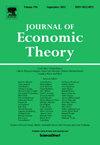开放经济中的市场与最优配置
IF 1.2
3区 经济学
Q3 ECONOMICS
引用次数: 0
摘要
大量的理论和定量工作涉及异质性企业和垄断竞争的模型。但其中大部分依赖于对需求结构、企业生产率分布和国家异质性的强有力假设。本文研究了一个具有直接明确的可加性偏好、非指定生产率分布和不对称国家的一般均衡模型,其中对这些模型的了解甚少。本文首先通过对竞争强度和工资的三阶段分析,证明了市场均衡的存在性和唯一性。然后,我们探讨了市场分配机制,并从全球计划者的角度提供了市场和功利主义最优之间的基线比较。我们发现,开放经济中的错配可以分解为两种效应,即由国家不对称和可变替代弹性驱动。我们给出两个分别展示常量和变量标记的例子来说明如何应用我们的一般定理。本文章由计算机程序翻译,如有差异,请以英文原文为准。
Market versus optimum allocation in open economies
A large body of theoretical and quantitative work concerns models of heterogeneous firms and monopolistic competition. But most of it relies on strong assumptions regarding demand structure, firm-productivity distribution, and country heterogeneity. This paper studies a general-equilibrium model with directly explicitly additive preferences, non-specified productivity distributions, and asymmetric countries, for which much less is known. We first prove the existence and uniqueness of the market equilibrium with a three-stage approach of analyzing competition intensities and wages. We then explore the market-allocation mechanism and provide a baseline comparison between the market and a utilitarian optimum from a global planner's perspective. We show that misallocation in open economies can be decomposed into two effects, driven by country asymmetry and the variable elasticity of substitution. We present two examples exhibiting constant and variable markups, respectively, to illustrate how to apply our general theorem.
求助全文
通过发布文献求助,成功后即可免费获取论文全文。
去求助
来源期刊

Journal of Economic Theory
ECONOMICS-
CiteScore
2.50
自引率
12.50%
发文量
135
期刊介绍:
The Journal of Economic Theory publishes original research on economic theory and emphasizes the theoretical analysis of economic models, including the study of related mathematical techniques. JET is the leading journal in economic theory. It is also one of nine core journals in all of economics. Among these journals, the Journal of Economic Theory ranks fourth in impact-adjusted citations.
 求助内容:
求助内容: 应助结果提醒方式:
应助结果提醒方式:


